| 1 | The USA’s top urban snake |
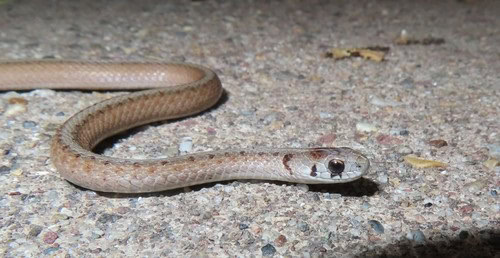
If you live in a city of the eastern USA, whether it’s Detroit, Cleveland or Pittsburgh, there’s one snake you’re more likely to meet in your garden than any other: Dekay’s brown snake (Storeria dekayi). This is a non-venomous, dull brown species with an average length of just 30-45cm, and an all-time record of 52.7cm.
With a consistently brown-grey body, Dekay’s brown snakes barely have any memorable features at all. But the one area where they beat other native US snakes is in their high adaptability to urban areas. This is the most common snake in several bustling cities, including Washington DC, Raleigh, New York, and more. Dekay’s brown snakes are not only common in urbanised zones where all remnants of wilderness have been stripped away, but thrive in them.
Locations you may find Dekay’s brown snakes include below garden chairs, in flowerbeds, beneath piles of cardboard, and even in swimming pools, forcing you to rescue them from drowning. Like the eastern brown snake of Australia, it’s believed that humanity has made this species more common, not less.
Unlike a timber rattlesnake (also common in the eastern US), Dekay’s brown snakes are completely safe to pick up, albeit relatively feisty. They lack even a mild venom, and their fangs are incapable of piercing a human being.
| 2 | Empire of Dekay’s brown snake |
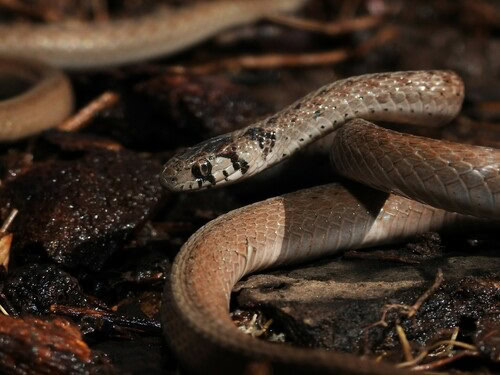
Look at a map, and you’ll see that Dekay’s brown snakes overwhelmingly concentrate in the eastern USA. They’re absent from western states like California, Oregon, Iowa, and even Colorado. Their westernmost point discovered so far lies in Lubbock County, Texas, although it’s always possible that there’s hidden colonies that scientists haven’t discovered yet (as this is a shy species). In 1922, a sighting was recorded in Roberts County, South Dakota. Whether this was made in error remains an unsolved mystery to this day, as they closely resemble several other small brown snakes.
Dekay’s brown snakes reach Montreal to the north, and are common in southern areas of Ontario. In the USA, they remain abundant all the way through to southeast Maine. To the south, Dekay’s brown snakes plunge beyond the border deep into Mexico. They’re abundant in the eastern half of Mexico, but are mostly missing from the west.
Finally, Dekay’s brown snakes have a strange isolated colony in Honduras and Guatemala, which is separated from the main bulk of the range. Here, they must coexist with coral snakes and rattlesnakes galore. Honduras is the furthest south this extremely abundant snake reaches.
| 3 | Diet: slugs and earthworms |
Being small themselves, Dekay’s brown snakes prey almost exclusively on small and slimy creatures. Slugs are their top priority, followed by earthworms, with millipedes and snails being recorded occasionally as well.
No reptiles, mammals, or amphibians have ever been reported in the diet of Dekay’s brown snake. In 2013, a study from northwest Pennsylvania decided to settle the debate for good. Of the 74 Dekay’s brown snakes examined, 47 contained slug remains, and 6 earthworm remains. Some of their popular prey included the blue-black garden slug and grey garden slug. They had finely tuned taste buds as well, as when they were offered white-lipped snails, they happily ate them, but they refused to consume dusky snails, for mysterious reasons.
Compared to other small US snakes, Dekay’s brown snakes have successfully cornered the slug market. They eat a few earthworms, but the rough earth snake, which lives in similar habitats, derives 100% of its meals from them. Ringneck snakes eat some slugs, but rely far more heavily on ants. This means that all 3 species can live in the eastern USA without outcompeting each other.
| 4 | A shelter-loving snake |
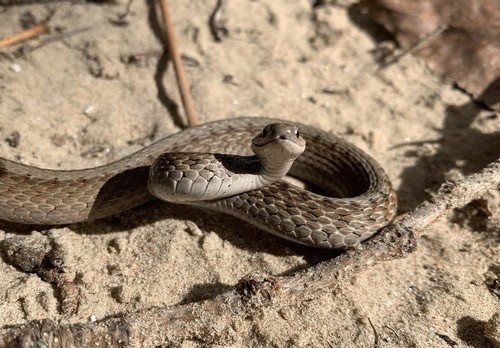
If you want to find a Dekay’s brown snake, then you have to remember one fact: they love to lurk under cover objects. This species dislikes being out in the open, regardless of where they live. In forests, they lurk in the upper layers of soil, below logs, and under flat rocks. In human zones, they lurk under scattered junk, loose stones, cardboard boxes. This love of cover is a survival strategy to compensate for their lack of venom.
Dekay’s brown snakes appear in many habitats, including wetlands, grasslands, and ancient forests alike. They have a tendency towards moist areas such as woodlands near rivers, without actually being fully aquatic. They’re also fond of abandoned agricultural land, and grassy, bushy verges adjacent to highways in places like Pennsylvania. They’re generally a solitary snake, which are less prone to gathering in large groups than the similarly shy ring-necked snake. However, gatherings of over 20 have been found occasionally.
One strange report came from the Little River Trail in Great Smoky Mountains National Park, Tennessee. Over summer 2009, a scientist watched a Dekay’s brown snake, copperhead, ringneck snake, common garter snake, timber rattlesnake, and northern watersnake share one hollow log with each other. Somehow, these species coexisted peacefully without ever coming into conflict.
| 5 | Defensive techniques |
The first goal of Dekay’s brown snake in hiding under cover is to stay near areas where their earthworm and slug prey congregate. The second reason is to hide from predators, which they have plenty of: blue jays, American crows, cats, brown thrashers, red-tailed hawks.
However, Dekay’s brown snakes aren’t completely cowardly. They’re significantly feistier than the similarly sized ringneck snake, which they’re occasionally mistaken for. Dekay’s brown snakes won’t react fondly to being picked up and restrained by a human. They won’t coil up in your arm and pray quietly that you drop them, as their first move is to release a revolting smell. Dekay’s brown snakes commonly bare their mouths wide in a demented pose, before making vicious lunges at their opponents, in a crazed attempt at intimidation (see their main image on Wikipedia).
Yet another Dekay’s brown snake skill is feigning death. Their favoured strategy is to flip on their back and remain totally motionless, like a corpse. Once they deem the coast to be clear, they rapidly dart away.
| 6 | Theatricality and deception |
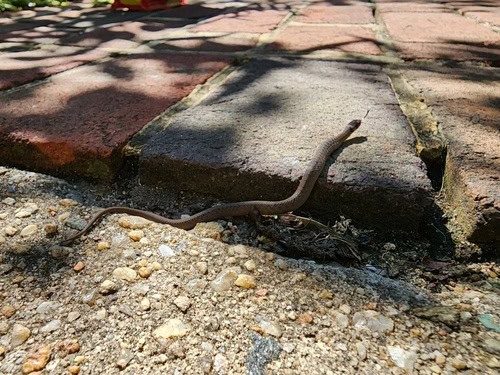
Dekay’s brown snakes have an assortment of weirder skills as well. This species is normally brown to the naked eye, but when stressed and fearful for their life, they can stretch the scales on their chest apart. This reveals the skin below, in a checkered pattern of rapidly alternating black and pure white. They’re able to widen their upper body to create an illusion of size, which may momentarily fool their many bird predators.
Though not commonly observed, an even stranger trick was discovered by scientists in May 2016. The location was Marsh Trail in Rondaeu Provincial Park in Ontario. A Dekay’s brown snake was found on a road, and began by producing a foul musky smell. As the researcher approached, the snake stayed perfectly still, and widened its back to add to its size.
Then came the weirdness, as the Dekay’s brown snake slithered slowly forward on the road, while swaying its back repeatedly from side to side. Most importantly, it did this while still stretched and enlarged, adding even more to the illusion of size and unhinged aggression. These techniques are almost certainly designed to addle the brains of bird predators such as blue jays and American robins.
| 7 | Preyed on by various snakes |
Dekay’s brown snakes also take steps to shield their brains, using their own coils as a protective armour. In a 1986 report, a scientist found an individual on a road in Point Pelee Matinal Park, Ontario. After poking the Dekay’s brown snake with his fingers, it coiled its body tightly and buried its head inside, shielding it from view.
A second Dekay’s brown snake in Michigan acted similarly, and a third (also from Michigan) hid its head for a full 120 seconds before peering upwards. The interesting thing was that when the scientist encountered three northern redbelly snakes (Storeria occipitomaculata), a close relative belonging to the same genus (with a redder appearance), none of these hid their heads in their coils.
Dekay’s brown snakes are proven to have several snake predators. In an investigation of milk snakes (Lampropeltis triangulum) from Oakville, Ontario, four individuals had Dekay’s brown snakes in their belly. A 13 inch ring-neck snake coughed up a 7 inch Dekay’s brown snake in Cowley County, Kansas, while a plains garter snake (Thamnophis radix) once regurgitated a Dekay’s brown snake, which was actually the first ever confirmed snake prey for that species.
| 8 | Correlates with ants and milipedes |
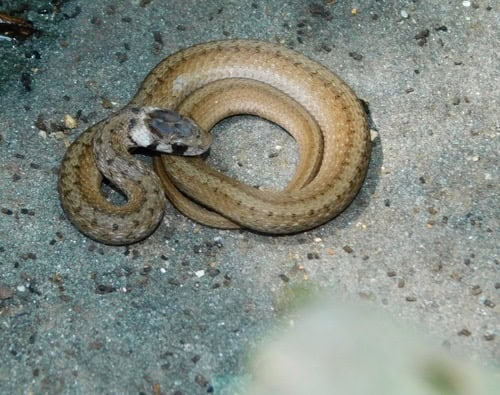
Even though they don’t eat ants and ants don’t eat them, it’s been noticed that Dekay’s brown snakes are more abundant where ants are concentrated. The explanation might be that they hide in anthills as shelter. Dekay’s brown snakes are likely to be found alongside millipedes as well, partly because they like the same moist, mulchy, surface level areas of accumulated forest debris.
However, there’s a couple of secret relationships which few are aware of. Dekay’s brown snakes occasionally eat millipedes, as a survey found 6 milipede remains when 74 individual Storeria dekayi were tested. All of these were spotted snake millipedes (Blaniulus guttulatus).
In reverse, millipedes are known to consume the shed skins of snakes. These forest mulch dwellers may have a mutually beneficial relationship. The same is true for earthworms, which known to use the shed skins of Dekay’s brown snakes to plug their burrows, while also forming part of their diet.
Dekay’s brown snake is part of the 5-member Storeria genus, and the most common worldwide. Other members include the red-bellied snake of the eastern US (Storeria occipitomaculata), and the Florida brown snake (Storeria victa).
| 9 | Unexplained mass gatherings |
Another strange piece of lore in the Dekay’s brown snake saga took place in Brazoria County, Texas. As we said earlier, this species isn’t especially communal. However, in December 2016, a scientist spotted 40 Dekay’s brown snakes trying to cross one highway, in a rare mass migration. There was a mixture of adult and juvenile snakes, alongside 24 Dekay’s brown snakes which had already become roadkill, making for 64 individuals in total.
What triggered this migration was a mystery. Another mass gathering was found below a bundled corn tarp inside a barn. This contained 24 resting Dekay’s brown snakes, including both juveniles and adults.
Dekay’s brown snakes hibernate each year just like any snake. In a survey from Eric County, Pennsylvania, the latest a Dekay’s brown snake was sighted was October 25th, while the earliest was January 6th. However, that came in a freakishly warm spell of weather, with an air temperature of 13.9c versus a January average of 1.1C. The earliest emergence apart from this January fluke was March 20th.
| 10 | How to ID Dekay’s brown snake |
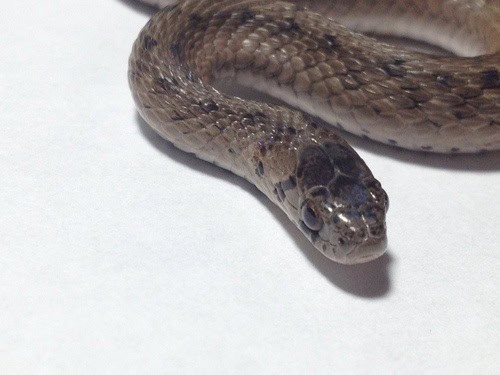
As a small brown snake, Dekay’s brown snake can be tricky to recognise. As juveniles, they have a pale neck collar which disappears in adulthood, leading some to be confused with ringneck snakes.
A typical Dekay’s brown snake is brown or beige, with a series of broken black spots down their sides. The head is darker than the body, and they usually have a pale belly with only occasional dark speckles. Dekay’s brown snakes have rough (keeled) scales to touch rather than smooth, and their pupils are round rather than vertical.
Overall, an adult Dekay’s brown snake is most likely to be confused with a rough earth snake (also found in the eastern US), but the latter has a narrower, more tapering snout. Rough earth snakes also have far less markings adorning their body, sticking to a consistent olive colour instead.
Dekay’s brown snakes lay live young rather than eggs, typically in batches of 4-20. These are born in late July to early August, and mothers provide no parental guidance or care to their offspring. This is the opposite of some rattlesnakes, which not only care for their young, but recruit fellow females as babysitters while they go out hunting.
